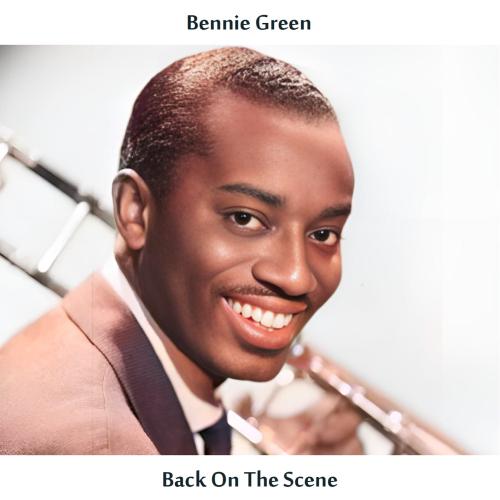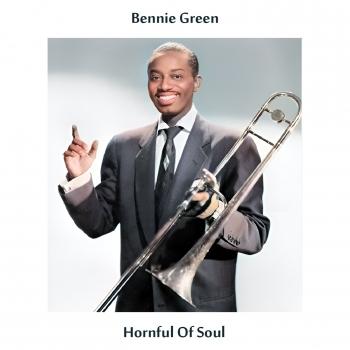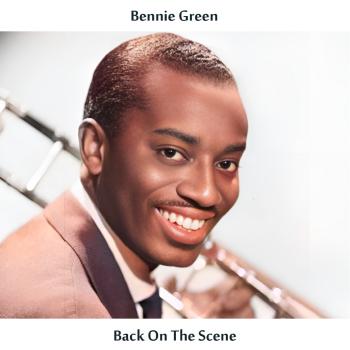
Back on the Scene (Remastered Stereo Edition) Bennie Green
Album info
Album-Release:
2024
HRA-Release:
19.11.2024
Album including Album cover
I`m sorry!
Dear HIGHRESAUDIO Visitor,
due to territorial constraints and also different releases dates in each country you currently can`t purchase this album. We are updating our release dates twice a week. So, please feel free to check from time-to-time, if the album is available for your country.
We suggest, that you bookmark the album and use our Short List function.
Thank you for your understanding and patience.
Yours sincerely, HIGHRESAUDIO
- 1 I Love You 06:02
- 2 Melba's Mood 05:32
- 3 Just Friends 06:59
- 4 You're Mine You 05:15
- 5 Bennie Plays the Blues 08:24
- 6 Green Street 05:08
Info for Back on the Scene (Remastered Stereo Edition)
A very tasty set that features several good tracks. The arrangements are inventive, and Green‘s trombone sound is nicely showcased with excellent support from this group. Set can appeal to mainstream devotees. Top tracks are I Love You, which is done in Latin tempo and a slow reading of You’re Mine You.
"It's evident from the opening pair of Latin-flavored performances that Back on the Scene is one of Bennie Green's most diverse efforts. Green's warm, supple tone and fondness for swinging, bop-influenced mainstream jazz and jump blues hasn't disappeared; he's just found new facets in his style.... Even with this vast array of styles, Back on the Scene retains all the good-natured spirit and humor of his earlier Prestige albums." (Stephen Thomas Erlewine, AMG)
Liner Notes by Leonard Feather: Before investigating the contents of this envelope it might be timely, in view of Bennie‘s recent absence from the spotlight, to review his personal background.
Born in Chicago, April 16, 1923, of a musical family that included a brother, Elbert, who played tenor sax with Roy Eldridge in the late 1930’s, Bennie found his first musical inspiration in the work of Trummy Young during the halcyon years of the Jimmie Lunceford band. Rummaging around in local second-hand stores to buy records for a dime apiece, he brightened his high school years with Trummy’s performances, as well as those of Lawrence Brown with Duke Ellington, with Red Allen; Tommy Dorsey and Bobby Byrne with their own late-swing-era bands. It was Trummy who had the major influence on Bennie in the evolution of his original style. He even went through a phase of copying the solos note for note off the Lunceford records, as well as some of Lawrence Brown’s. At Du Sable High School, he took lessons from the band director, later playing his first gigs with King Kolax and other bands around town.
In the summer of 1942 the Earl Hines band came through Chicago. Someone recommended Bennie to Budd Johnson, who was playing tenor and arranging for the band; Budd listened to Bennie and promptly asked him to join.
The Hines band of that era was an academy for aspiring youngsters, since its ranks, during the year or so Bennie spent there before he was drafted, included Dizzy Gillespie, Charlie Parker and other angry young men of the incipient bop movement. After Diz joined the band Bennie spent a great deal of time sitting right in front of him listening, understanding a little but liking a lot. Diz went to the trouble of taking Bennie to his home and demonstrating, on the piano, some of the melodic ideas and uses of substitution chords that governed his style. Before long Bennie, who had been a reluctant ad libber, found himself improvising more and more.
After two years in the service, spent mainly in the 343rd Army Band in Illinois, Bennie was discharged early in 1946, rejoined Hines in May and remained until January, 1948. After working briefly with Gene Ammons’ combo he formed what was to be his most commercially valuable association, joining Charlie Ventura’s combo and touring with him for almost three years. Ventura at that time was the most popular small combo leader in jazz, occupying a niche comparable with, say, the Modern Jazz Quartet or Brubeck’s group today in terms of poll-winning popularity. As the most-featured sideman, in a group that usually included only one or two other horns, Bennie earned valuable exposure with Ventura on tour, in concerts, and frequently on records. During this time his style became more firmly established than ever, and it was evident that his leanings were in a modern direction that had been guided by the early opportunity to observe Gillespie at close hand. ”Jay Jay is the man,” he told a Down Beat reporter in 1949. ”He’s my favorite.”
Writing in an English magazine of one of Bennie’s recorded solos around that time, critic Raymond Horricks said, ”His execution is clearly defined, non-exhibitionistic and liberally impregnated with the devices and characteristic phrasing of the be-bop style, yet he always manages to retain something of the real jam session atmosphere. His tone is unique – a compromise between the hot swinging tone of J.C. Higginbotham and the cool, calculated one of Bill Harris. To my mind it is the cleanest tone I can ever recall having heard, only Lawrence Brown’s coming anywhere near by comparison.”
Soon after leaving Ventura, Bennie rejoined Earl Hines, who by this time was leading a sextet. His final association with the Fatha lasted from 1951 to ’53, when Bennie formed his own quintet. Before long such extrovert up-tempo blues items as Blow Your Horn and I Wanna Blow had achieved the quality of swinging excitement sometimes associated with the Jazz at the Philharmonic school of jazz, though more clearly defined and organized in the case of Bennie’s unique quintet.
That was the kind of band you will hear exultantly recreated on the present sides. Sharing the front line with Bennie is tenor saxophonist Charlie Rouse, who was a member of his combo back in 1955. Rouse, a Washingtonian, born in 1924, had his first name-band associations with Billy Eckstine in 1944, Dizzy Gillespie in ’45, and was a member of the Ellington band from 1949-50. Pianist Joe Knight, born May 14, 1922 in Brooklyn, played with Hot Lips Page from 1947-51, then spent a year with Earl Bostic, later working with Lucky Thompson’s group and freelancing around New York with Kenny Burrell and others. Drummer Louis Hayes is familiar to Blue Note collectors as the promising young Horace Silver discovery featured with Horace’s quintet on all his recent releases. Bassist George Tucker, born December 10, 1927 in Palatka, Florida, came to New York in 1948 and studied at New York Conservatory. He toured with Earl Bostic from 1954-56, and has free-lanced with Sonny Stitt, John Coltrane and numerous Brooklyn combos.
Cole Porter’s I Love You opens the session using a Latin rhythm motif that is continued off and on in the three tracks on this side. Bennie soars out of the break at the end of the ensemble chorus into a long and characteristic ad lib solo. Rouse starts by sparring with the melody but soon catapults into the occasional sixteenth-note flurries that lend variety and a constant beat to his work. After Knight’s solo the theme returns for a half-chorus.
Melba’s Mood is one of two originals contributed to the session by Melba Liston, who is a trombonist and composer like Bennie, but, as we are sure Bennie will agree, much prettier. She was with the Gillespie band, playing and writing, from 1956 until shortly before its break-up, and has been free-lancing in New York since late 1957. Melba’s is a minor mood, we observe, with Bennie contributing a muted offering and with the horns effectively added during the bridge on the piano solo.
The tempo shifts into high, but the Latin motif is retained, at least briefly, for the revival of Just Friends, a standard tune best known to jazz fans through a memorable Charlie Parker version almost a decade ago. There is more than a touch of Sonny Rollins in the outstanding Rouse solo on this one. Bennie, as has always been his want, is completely in control of this tempo. The piano, though relatively chary in the use of notes, swings easily. The theme returns, voiced mainly in fifths, and there is a sudden, bop-era-style ending.
You’re Mine You, by coincidence not design, is the same tune interpreted by another trombonist, the eminent J.J. Johnson, on BLP 1506. Writing of that version I pointed out that the tune had been too rarely recorded, that it was produced by the same team (Edwin Heyman and Johnny Green) that wrote Body and Soul, and added ”Jay Jay takes the melody solo, in a style that is at once languorous and sentimental, yet vigorous and virile.” Not surprisingly, the same four adjectives might aptly be applied to Bennie’s version.
Bennie Plays the Blues typifies the kind of frenzy-whipping groove that used to be achieved by the original Green quintet. After a fast twelve-bar piano solo, a riff is established for two choruses, then Bennie sails away, for thirteen choruses. At one point he may be all over the horn, showing an astonishing alliance of technique and inspiration, while at another juncture he may be varying the mood by staying on one note almost throughout a twelve-bar chorus, as he does on the tonic in his first and seventh choruses and on the flatted third on the last chorus before Rouse takes over. The long tenor and piano solos are followed by some unison and voiced rifting; Bennie takes over for a couple more choruses before the rift returns to seal it off.
Green Street, another Melba Liston original, has a 32-bar chorus that launches both Charlie and Bennie into some of their best work on the entire session. There are Wynton Kellyish touches to Joe Knight’s work here; Hayes’ superlative control is noteworthy throughout and the rhythm section as a whole conveys a mood of swinging solidity.
In writing of Bennie Green I am admittedly working under a prejudice, having known him almost since the start of his career, and having voted for him in polls long before some of his present and potential future fans have acquired an interest in jazz. I can only hope that these future Green converts will join with his innumerable past admirers in welcoming Bennie Green back on the scene.
Bennie Green, trombone
Charlie Rouse, tenor saxophone
Joe Knight, piano
George Tucker, double bass
Louis Hayes, drums
Recorded March 23, 1958 at Van Gelder Studio, Hackensack, NJ
Engineered by Rudy Van Gelder
Produced by Alfred Lion
Digitally remastered
Bennie Green
was one of the few trombonists of the 1950s who played in a style not influenced by J.J. Johnson. His witty sound and full tone looked backwards to the swing era yet was open to the influence of R&B. After playing locally in Chicago, he was with the Earl Hines Orchestra during 1942-1948 (except for two years in the military). Green gained some fame for his work with Charlie Ventura (1948-1950) before joining Earl Hines’ small group (1951-1953). He then led his own group throughout the 1950s and ’60s, using such sidemen as Cliff Smalls, Charlie Rouse, Eric Dixon, Paul Chambers, Louis Hayes, Sonny Clark, Gildo Mahones, and Jimmy Forrest. Green recorded regularly as a leader through the 1950s-60s including 3 albums for Blue Note: Back on the Scene (1958), Soul Stirrin’ (1958), and Walkin’ and Talkin’ (1959). Bennie Green was with Duke Ellington for a few months in 1968-1969 and then moved to Las Vegas, where he spent his last years working in hotel bands, although he did emerge to play quite well at the 1972 Newport Jazz Festival and in New York jam sessions.
This album contains no booklet.










